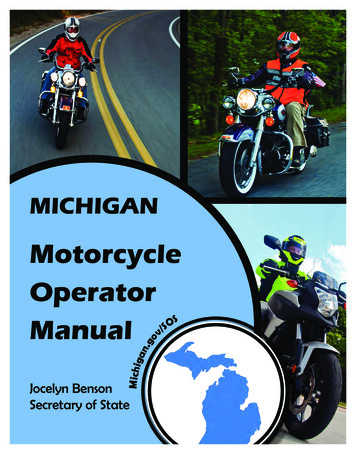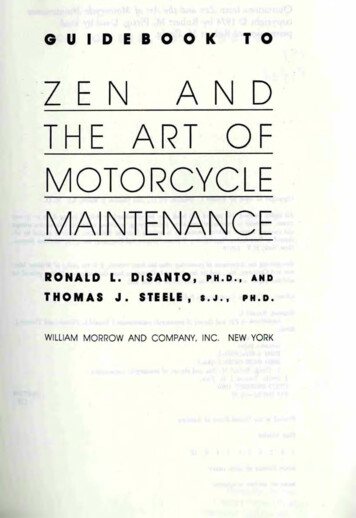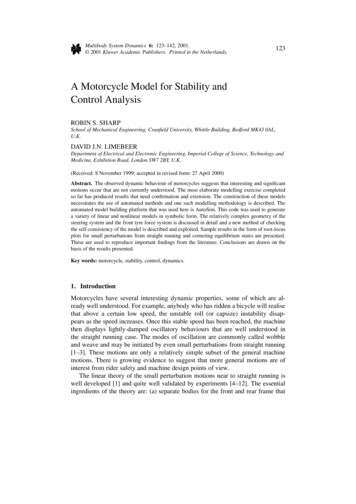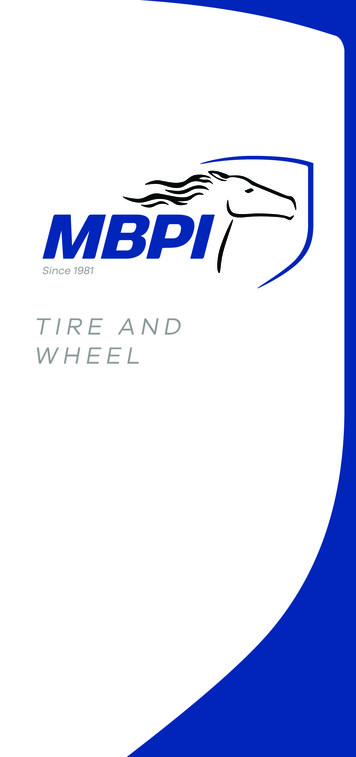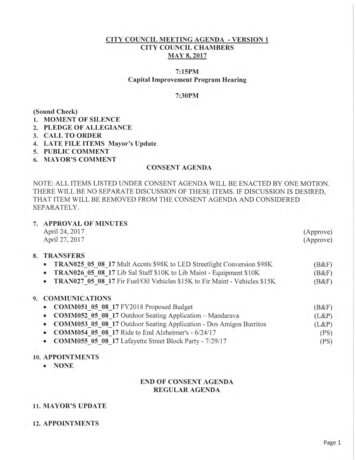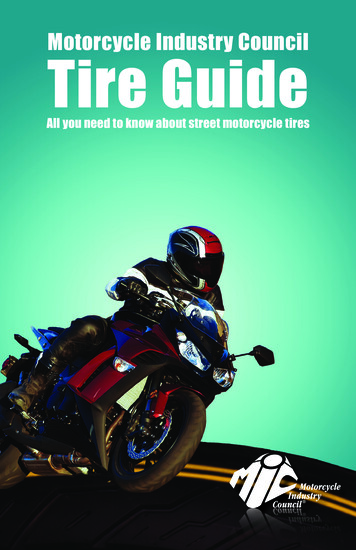
Transcription
Motorcycle Industry CouncilTire GuideAll you need to know about street motorcycle tiresMotorcycle Industry Council Tire Guide1
The information in this booklet represents the collective knowledge of a number ofmotorcycle tire manufacturers and Motorcycle Industry Council staff and is intendedto be a useful resource for motorcyclists. This booklet, however, cannot cover everypossible example or aspect of tire usage. Consult the appropriate motorcycle or tiremanufacturer for issues not addressed in this booklet.
IntroductionNever underestimatethe importanceof having good,properly inflated tires on yourmotorcycle.The small contactpatchesprovided by thefront and reartires are them o t o rc y c l e ’sonly source oftraction. Deterioration of your tires’ condition can jeopardize this contact patch andbring a good ride to a quick end.Safe riding depends on selecting the right tires, inspecting andmaintaining them, and replacing them as necessary.Inspection and MaintenanceIt’s all about inflation, inflation, inflation. Proper air pressure is criticalfor tire performance and tire life. Under-inflation or overloading cancause sluggish handling, heavy steering, and internal damage due toover-flexing, and can cause the tire to separate from the rim. Overinflation can reduce the contact area (and therefore available traction), and can make the motorcycle react harshly to bumps. CheckMotorcycle Industry Council Tire Guide3
Tire PressuresLOADTIRE PRESSURE (COLD)FRONTREARPSIkPaPSIkPaSolo rider3624836248Rider and passenger3624840276TYPESIZEOPTION 1OPTION 2frontMOUNTradial-ply, tubeless120/70 ZR17Brand X - FBrand Y - Frearradial-ply, tubeless190/50 ZR17Brand X - RBrand Y - Rpage 22 SpecificationsOwner’s manualthe air pressure when thetires are cold (at least threehours since the last ride),as part of your pre-ride“T-CLOCS” inspection (TCLOCS means Tires andWheels, Controls, Lights,Oil, and Stands; see page15 for a complete MSFT-CLOCS checklist), andadjust it according to yourmotorcycle’s owner’s manual or the tire informationlabel on the chain guard, frame or swingarm. There may be two setsof recommendations for tire pressure (as well as suspension settings):one for solo riding and one for riding with a passenger and/or cargo.Do not exceed the maximum inflation pressure listed on the tire’s sidewall. And never exceed the motorcycle’s or tire’s load limit (combinedweight of operator, passenger, cargo, and accessories), since that cancause tire failure. (Refer to the Load Limit Calculator on page 18.)Some riders eventually reduce the frequency of air pressure checks toat least once a week and before long trips, but will still visually inspecttires before each ride.Regularly inspect the tire tread depth to ensure that adequate treadremains. Tires have small wear bars molded into the tread grooves.When the tread is worn down to the level of the wear bars (indicating1/32 inches of tread remaining), the wear bars become exposed andthe tire should be replaced. Some manufacturers recommend replacing the tire when there are 2/32 or 3/32 inches of tread remaining. Al4Motorcycle Industry Council Tire Guide
though it may look like there isa sufficient amount, it may notbe enough to maintain tractionin wet conditions. The deepgrooves in fresh tires helpchannel water away from thecontact patch, and worn tiresare thinner and easier to puncture. For a quick check, if youinsert a penny into a groovein the center of your tire, 2/32of an inch is right at the top ofLincoln’s head.In addition to tread depth,glance over the tires’ surfacefor any evidence of unevenwear, cuts, embedded objects,bulges, or sidewall cracking.This photograph shows how water is squeezedfrom the path of a tire.Every time you ride, the tires go through a “heat cycle” as they gofrom ambient to operating temperature and back down again. Eachsuccessive heat cycle slowly hardens the tire. Similarly, as tires age,chemical reactions cause the rubber to harden, even during nonuse.Whether through heat cycles or aging, the tire’s surface becomesless spongy and less able to interlock with the protrusions and poresin the road surface. (If you have an old tire and a new tire, you canpress your fingernail into the surfaces of each to see the difference inhow they react.) Tires can also absorb petroleum-based fluids fromthe road, which can further deteriorate the rubber. So, tires eventuallyhave to be replaced, even if they have plenty of tread left. And don’tMotorcycle Industry Council Tire Guide5
take a chance on buying used tires; you don’t know how many heatcycles they’ve gone through. This also means that when you buy aused motorcycle, you should thoroughly inspect the tires, and replacethem if their condition is questionable.To clean your sidewalls, use a mild soap solution and rinse off withplain water. Do not use chemical cleaners or protectants, as they maydegrade the rubber and cause cracks in the sidewalls.If you’ll be storing your motorcycle for more than a month, and it has acenter stand, set the bike on its center stand to raise the rear tire off theground and use blocks under the frame to lift the front tire slightly offthe ground. If it doesn’t have a center stand, periodically roll the bikeforward or backward a few inches so the tires don’t develop flat spotsin the tread.The RideRubber is harder when it’s cold than when warmed up. Motorcycletires are designed to provide maximum traction at specific temperatures. Riding moderately for the first few miles on the street will allowyour tires to come up to proper operating temperature. Don’t take thefreeway on-ramp near your home at maximum lean angle and cornering speed before your tires come up to temperature. Tire temperatureis so important that professional racers actually use electric tire blankets to preheat the tires so they’ll have maximum grip when the greenflag drops out on the track.6Motorcycle Industry Council Tire Guide
Selecting a TireYour motorcycle was designed to work in harmony with a limitedselection of tires. The owner’s manual will specify tire size, construction (radial or bias, tube-type or tubeless), load range, and speedindex, and may identify the brand installed as original equipment. Inaddition, tires are specifically designed for use only on the front or rearwheel – because each tire has a different function – and the front andrear tires should match each other by being from the same brand andmodel line. Tires must also be mounted so the sidewall arrows correspond to the direction of travel.Motorcycle dealerships can recommend a variety of brands and typeswithin brands that best match your motorcycle and style of riding,whether commuting, touring, sport riding, or on- and off-road adventure riding. Some tires even use two different rubber compounds in thetread: a harder compound in the center for extra life when riding in astraight line and a softer compound on the outer edges for extra traction while leaning through turns. Note, too, that different tread patternscan make a difference in how your bike handles. For example, somepatterns will resist tracking on the rain grooves that are cut into somehighways.And never mount a passenger car tire on a motorcycle rim; the flatprofile of a car tire is incompatible with the dynamics of a vehicle thatleans as it corners, and the section of the tire in contact with the rim(the “bead”) is incompatible with motorcycle rims.Motorcycle Industry Council Tire Guide7
Tire Sidewall InformationEvery street-legal tire sold in the U.S. will have a Department ofTransportation (DOT) serial number on the sidewall. The serial number begins with the letters “DOT” and ends with a four-digit date code(if there are only three numerals, the tire was made before 2000 andshould be discarded). The four digits represent the week and yearof production. For example, a date code of “4510” in the first photomeans the tire was produced in the 45th week of 2010.The sidewall will alsohave a code indicatingthe size, plus a loadindex and a speedindex as shown in theseexamples.The examples use metric designations. Thefirst number is the nominal tread width, in millimeters, 160 mm in thesecond photo, 120 mmin the third. The secondnumber is the aspectratio (ratio of tire heightto tread width) which isa percentage, so for the160/60 the tire height is60 percent of the treadwidth, or 96 mm; for the120/80 the tire height is80 percent of the treadwidth, which also happens to be 96 mm. Sometires use letter or inchdesignations instead ofmillimeters, as shown inthe chart on page 10.In the second photo the “R” means radial-ply construction. In the thirdthe “-” means bias construction. A “B” would mean bias-belted.Next is rim diameter, in inches: 17 in the second photo, 18 in the third.The “M/C” means the tire was designed for motorcycles.8Motorcycle Industry Council Tire Guide
The next set of characters indicate load index and speed index. The“69” and “62” indicate the maximum load the tire can carry (see LoadIndex Rating chart below) at the speed indicated by the speed indexes“(W)” and “H,” respectively (see Speed Index chart on the next page).In the chart, note that the W in parentheses has a different rating thana W without parentheses. Also note that tires with a “W” or “(W)” speedindex are identified by a “Z” before the construction code in the tiresize designation.Load Index As all street-legal tires are capable of handling the full range of postedspeed limits nationwide, the higher maximum speeds shown in theSpeed Index chart (page 10) are intended only for certain high-speedEuropean road use applications and those participating in track daysor other closed-course, sanctioned competition events.Motorcycle Industry Council Tire Guide9
Speed Index ChartSpeed IndexMaximum SpeedP93 mphQ99 mphR106 mphS112 mphT118 mphU124 mphH130 mphV149 mph*W168 mph**(W)more than 168 mph*** At speeds above 130 mph, the maximum permissible load is reduced. Consult tire manufacturer for details.** At speeds above 149 mph, the maximum permissible load is reduced. Consult tire manufacturer for details.Cross-Reference Chart for Popular Tire SizesFRONT TIRESMetricAlphaInch80/90MH902.50 to 2.7590/90MJ902.75 to 3.00100/90MM903.25 to 3.50110/90MN903.75 to 4.00120/80–4.25 to 4.50120/90MR904.25 to 4.50130/90MT905.00 to 5.10REAR TIRES10MetricAlphaInch110/90MP854.00 to 4.25120/90MR904.50 to 4.75130/80–5.00 to 5.10130/90MT905.00 to 5.10140/80–5.50 to 6.00140/90MU85/MU905.50 to 6.00150/80MV856.00 to 6.25150/90MV856.00 to 6.25Motorcycle Industry Council Tire Guide
Mounting The TiresTires shouldbe replacedand balancedby a professional mechanic. Professionals have theright tools toprevent damage to the beadof the tire whichmust seat firmlyagainst the rimto provide anairtightseal,and they haveequipment that can perform dynamic, high-speed balancing to guardagainst wheel vibration. Valve stems (and tubes, for tube-type tires)should be replaced every time a tire is replaced.New tires typically have a slippery surface. Take it easy on your first 100miles as the tire’s surface “scuffs in” and provides maximum grip. Thisbreak-in period also gives you time to adjust to the difference in howthe new tires feel compared to the old, worn tires – like getting use toa new pair of shoes.Motorcycle Industry Council Tire Guide11
How Motorcycle Tires WorkBecauseamotorcycleis a single-trackvehicleandleans as it turns,motorcycle tiresare quite different than cartires. Whereascar tires have afairly flat profileCGand a contactCFpatch that varLeanies little in sizeAngleor shape, motorcycle tires havea U-shaped proWTLfile and a contact patch thatchangessizeand shape during cornering. Motorcycle tires are also relatively narrow,which makes their gripping capability (“traction”) a limited commodity. Plus, this limited amount of traction is divided up among multipleforces created when braking, cornering, and accelerating. The moreyou lean in a corner, for example, the less traction is available for braking; the quicker you accelerate, the less traction is available for turning.If any one of these actions uses an excessive share of available traction,you might lose control of the motorcycle. For more information on howmotorcyclists can manage braking, cornering, and acceleration forces,please read the Motorcycle Safety Foundation’s Guide to MotorcyclingExcellence (Second Edition), or any number of in-depth books on the artand science of motorcycling.Tractioncanbethought of as themechanicaladhesion between tiresand road surface.Predictable tractionis essential in all riding situations, especially cornering. Toenable this connec12Poor TractionGood TractionLateral ForceLateral ForceMotorcycle Industry Council Tire Guide
tion to transmit as much force as possible, it is necessary for the tire’srubber surface to interlock at the microscopic level with the protrusionsand pores of the road. That means there must be sufficient tread thickness, and it must be flexible (like a sponge).There are several ways in which the adhesion between rubber and roadcan be compromised:The tire surface has lost its elasticity,temperatures, aging, or other factorsbecauseofcoldThe asphalt or concrete has been “polished” down and made smoothby automobile and truck tiresThe interface between tire and road is “lubricated” or obstructedby any number of substances: rainwater, engine oil, leaves, gravel,sand, dirt, etc.Tire FailureAtire blowout can occur suddenly and without warning, and can induce panic even in experienced riders. You may feel a vibrationor sluggish handling depending on the cause of failure. If a blowoutshould occur, keep a firm grip on the hand
motorcycle tire manufacturers and Motorcycle Industry Council staff and is intended to be a useful resource for motorcyclists. This booklet, however, cannot cover every possible example or aspect of tire usage. Consult the appropriate motorcycle or tire manufacturer for issues not addressed in this booklet. Motorcycle Industry Council Tire Guide 3 IntroductIon Never under-estimate the .

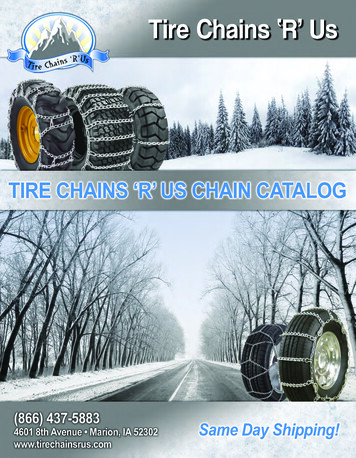
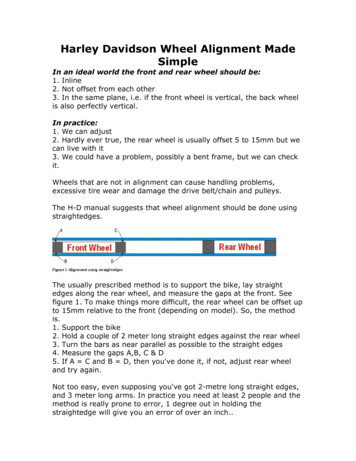
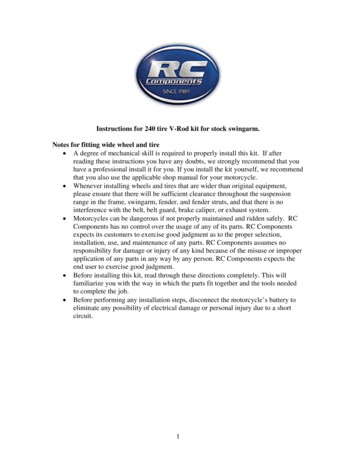
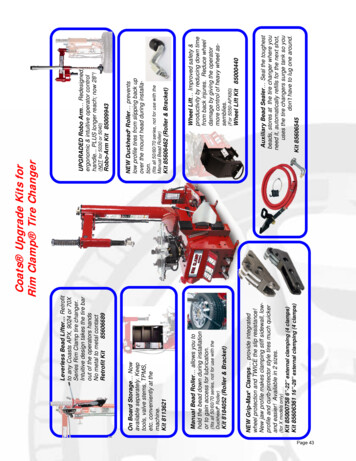
![Motorcycle Mechanic [MM] - CTEVT](/img/5/motorcycle-20-20mechanic-2010.jpg)
